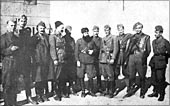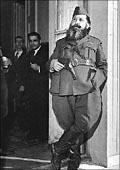 |
||||
|
||||
 |
| The resistance organizations of Greece
The foundation of the National Republican Greek League (EDES) took place in the same month, under the political leadership of General Nikolaos Plastiras, while its military leadership was assigned to General Napoleon Zervas. It formed guerilla forces, the Greek Fighters' National Groups
Later, in April 1943, a third resistance group was founded, National and Social Liberation (EKKA), also by army officers with democratic and anti-royalist feelings, with Georgios Kartalis as their political mouthpiece. The military branch of this group was a guerilla body under the leadership of Colonel Dimitrios Psarros and their field of action was mainly the mountain of Giona. All three resistance groups aimed at restoring democratic legality in Greece after the war as stated in their statutes, expressing the generalized popular demand, after the traumatic experiences of the authoritarian Regime of Metaxas, for parliamentarty legality, recognition of the free popular will and social and political reform. In summer 1942 the first two guerilla forces were already active in the Greek mountains, yet it must be said that in many parts of Greece sporadic armed clashes had begun taking place a little earlier, while in Crete there was virtually no period of inertia from the end of the war until the first manifestations of resistance activity. There were more resistance organizations active during the Occupation both in the city and the countryside in the form of armed groups in immediate association with the General Staff of the Allies' forces in the Middle East. Some of them were: Holy Brigade, Omiros, Kodros, Promithefs and Midas 614. The latter was led by the officer Ioannis Tsigantes, who was killed in an engagement with the Italians in January 1943. |
||||




